ASUS K53E: Testing Dual-Core Sandy Bridge
by Jarred Walton on April 8, 2011 1:00 AM EST- Posted in
- Laptops
- Intel
- Sandy Bridge
- Asus
Sandy Bridge Gaming Performance, One More Time
After the 3DMark results, and considering our previous look at SNB’s GPU performance, there’s not much new to say here. We’re still working on a full roundup of gaming performance and compatibility testing with Sandy Bridge, similar to what we did with the AMD E-350. Our standard suite of laptop gaming tests all ran without any apparent compatibility problems, but given this list hasn’t changed much Intel has had ample time to make sure these titles work. We’ve run the Low and Medium performance tests, with a selection of competing laptops in the charts below.
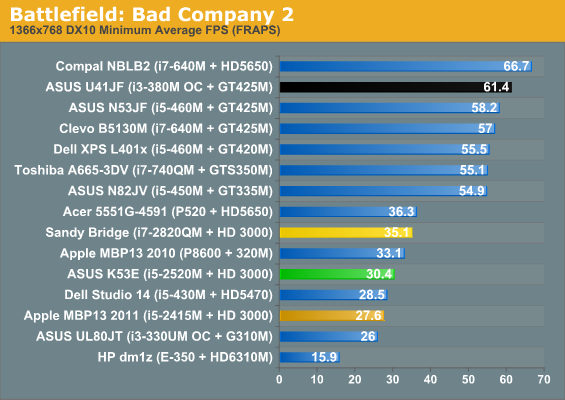
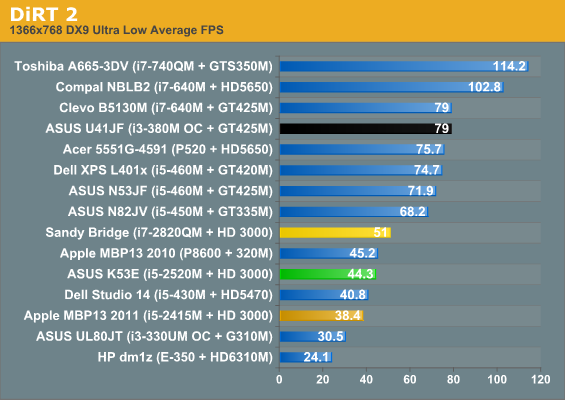
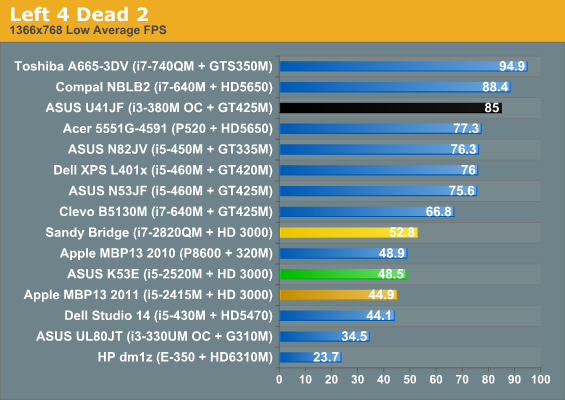
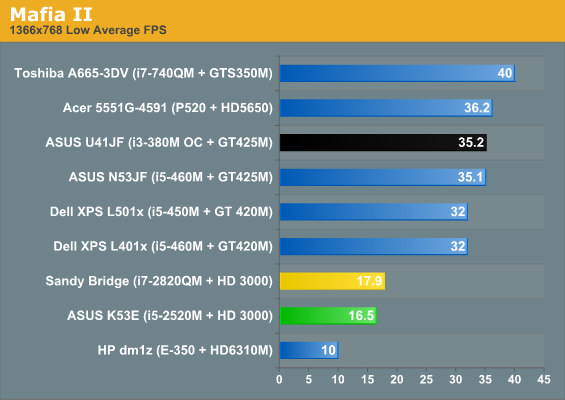
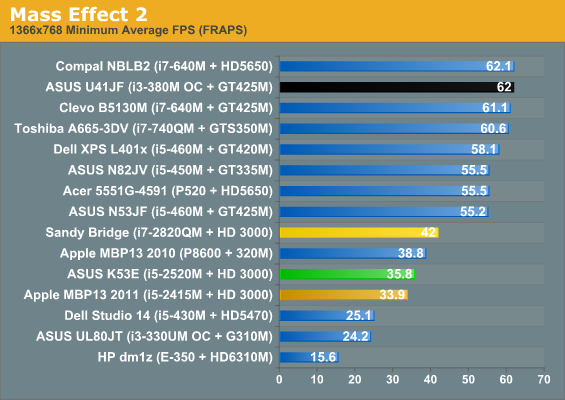
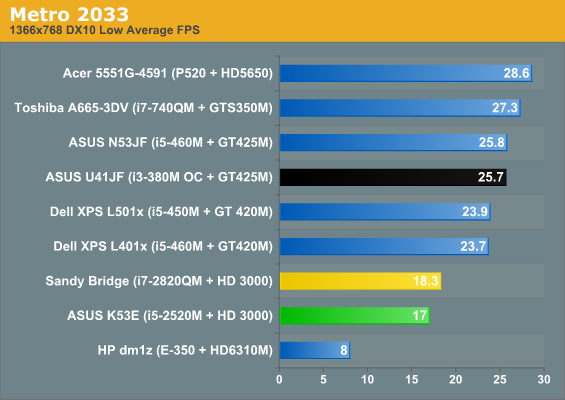
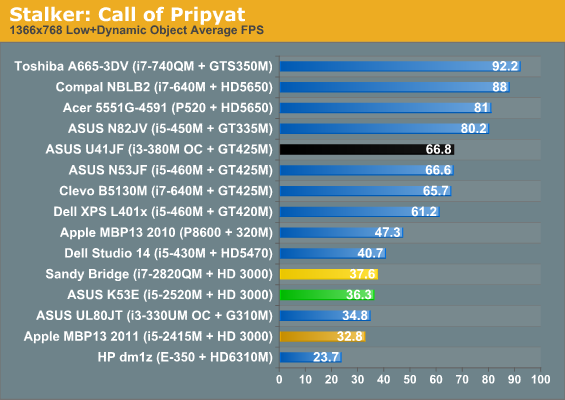
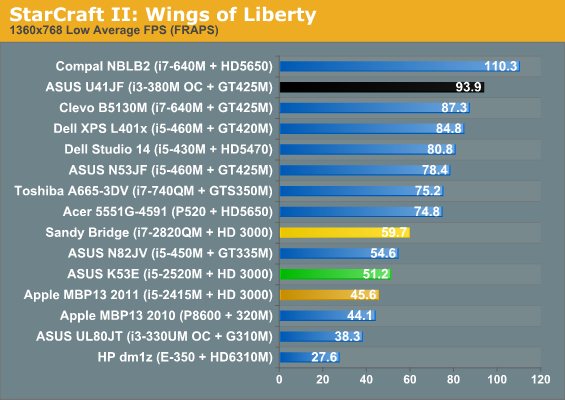
As we noted in the ASUS U41JF review, Intel’s relative standings in graphics are better with 3DMark than with actual games, particularly when we look at midrange GPUs like the GT 425M and HD 5650. Where the U41JF leads the K53E by 53% in the four 3DMark tests, in our eight actual games at low detail that increases to an 82% advantage. The K53E still leads the MBP13 2011 by 10%, and the i7-2820QM in turn leads the K53E by 12%—those results are the same as 3DMark, but then we’re dealing with the same IGP in all those cases. In terms of actual performance, the K53E breaks the 30FPS mark in six of the eight titles—Mafia II and Metro 2033 being the standard exceptions, but then those often fail to break 30FPS even on discrete GPUs.
What about the AMD E-350 comparison? As we just finished discussing, 3DMark shows the K53E coming in 125% faster than the E-350, though as we’ve noted in the past 3DMark can either skew things too much or too little towards CPU performance. Move over to our suite of games and the K53E still posts much higher scores than the E-350, but now the margin of victory is 88%. That’s still nearly twice the performance, and for a complete laptop you’re looking at around $725 versus $500 for similar components elsewhere. 45% more money for 88% faster graphics and 300% faster CPU performance isn’t a bad deal; what you don’t get with Sandy Bridge at that price is 8+ hours of battery life in an 11.6”-screen chassis.
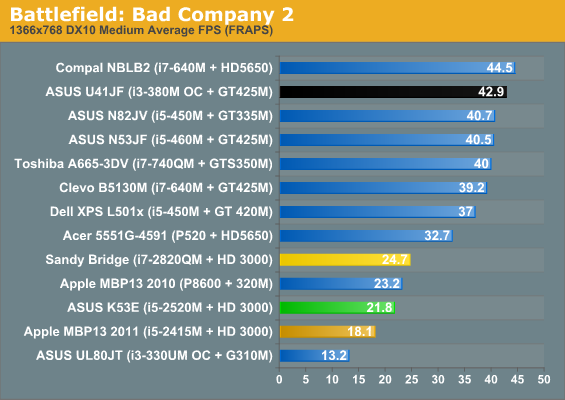


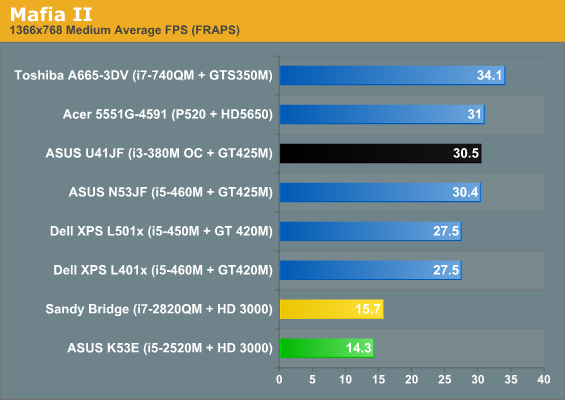

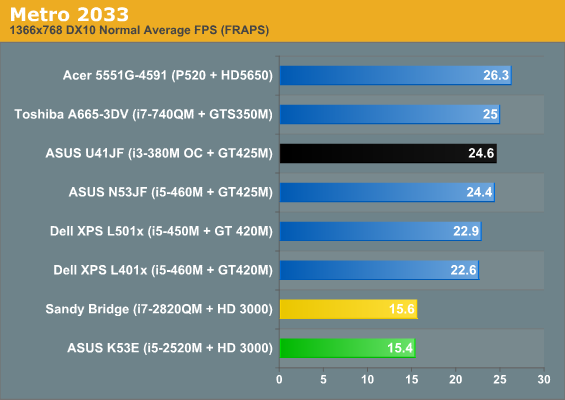
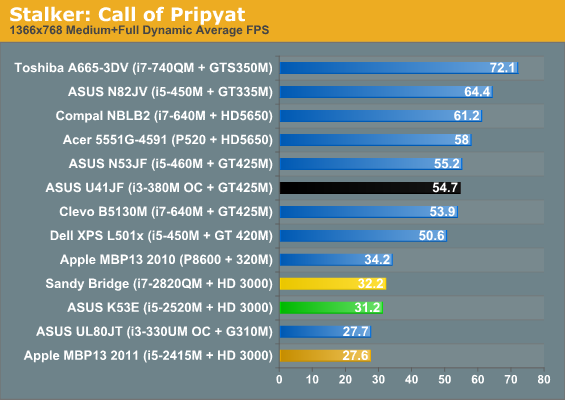
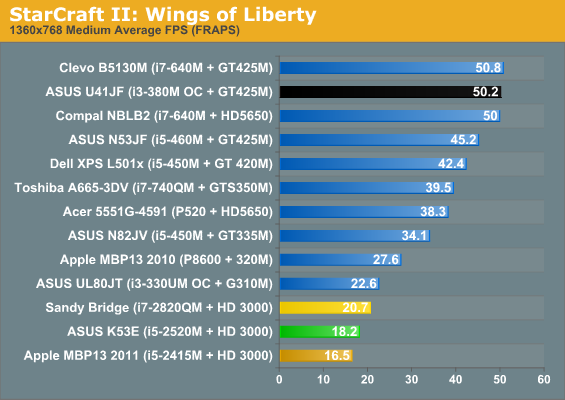
At medium detail settings, HD 3000 performance drops relative to the discrete GPUs. The K53E manages to hit 30FPS or higher in exactly one game this time: STALKER. It’s still 11% faster than the MBP13 2011, and the 2820QM is 14% faster than the K53E. Interesting to note is that the MBP13 2010 is also 15% faster than the K53, putting the GeForce 320M on the same level as the HD 3000 with quad-core CPU. By far the more pertinent piece of information is just how badly the U41JF trounces the K53E: Arrandale with a midrange dGPU comes out nearly 100% faster on average at our “Medium” settings, and it breaks 30FPS in every game in the list except Metro 2033.
For people looking to get an all-around laptop that can play games and provide adequate performance for general use, discrete GPUs are still required. Even then, midrange mobile GPUs are going to struggle with a lot of titles unless you turn down the detail settings and run at moderate (e.g. 720p) resolutions. On the other hand, if you’re not serious about gaming and graphics, Sandy Bridge’s IGP is very likely to satisfy the vast majority of users. Thankfully, it also manages to raise the bar relative to previous IGPs, with roughly double the performance of Arrandale’s HD Graphics and AMD’s HD 4250.
Rounding out the graphics discussion, other areas where the GPU helps also performed well. Viewing HD 1080p YouTube videos worked without any issues I could detect, thanks at least in part to the latest release of Adobe’s Flash player. Casual browser games like Bejeweled Blitz also worked fine, which isn’t something I could say on Arrandale where there was always a slightly perceptible delay—and that’s also a complaint I had with Brazos, which didn’t do well with Bejeweled Blitz. One interesting piece of information, however, is that the K53E really did poorly in Civilization V testing (not shown here, but you can see the scores in Mobile Bench), but whether that’s a driver problem or something else I can’t say.
Overall, gaming and graphics isn’t an absolute victory for Intel’s latest IGP, but it’s good enough for a large percentage of users. In the next month or so, we’ll see AMD’s counter to SNB with their second Fusion APU, Llano. That should provide at least double the GPU performance of Brazos, and even the aging K10.5 CPU core is a huge step up in performance from Bobcat. The combination should put Llano well ahead of HD 3000 in gaming, but whether it will be 50% faster or 100% faster we can't say for certain.
With a 32nm process technology and better use of power gating, Llano is going to be an interesting alternative, especially if the total system cost is similar to the $500 to $650 we’re seeing on current AMD notebooks. Sandy Bridge is unlikely to be touched for CPU computations by any of AMD’s mobile CPUs for the remainder of 2011, but with up to 400 Stream Processors Llano should come relatively close to the HD 6500 (HD 5600) series GPU performance. Put another way, while Intel’s HD 3000 is about twice the performance of Brazos’ IGP, Llano could easily double HD 3000. It’s a welcome change from the 15 to 25% improvements in IGP performance we often saw in previous platforms.










78 Comments
View All Comments
JarredWalton - Friday, April 8, 2011 - link
Our battery life testing has always targeted maximum battery life while still being able to complete all tasks. So with Core 2 Duo, Athlon II, Core i-series, etc. we've always set minimum CPU and maximum CPU to 0%, and enabled any special power saving features as applicable. (I should note that there are exceptions to the above: Atom, Brazos, and CULV/ULV have always been tested at 0/100% CPU settings, mostly because they are already slow--particularly Atom. The laptop needs to be able to play our H.264 video without stuttering or dropping frames.) On the ASUS U41JF, if you use the "Battery Saving" Power4Gear profile, it automatically underclocks and locks the CPU to run at no more than 900MHz. Running stock instead of underclocked reduces battery life by 5-10% as noted in the U41JF review. Finally, as I point out, it's interesting that for SNB, 0/0% actually reduces battery life compared to 0/100% CPU in two of the three battery tests--this is not the case with Arrandale.Regarding power efficiency: 10 to 15% better efficiency is "similar" in my book. The 30% difference in H.264 is a lot more pronounced, true. As for SSD vs. HDD, SSDs really don't use that much less power at idle, and often even under load. Look at the ASUS U30Jc with an SSD comparison: http://www.anandtech.com/bench/Product/266?vs=267 SSD wins by 7% at idle, HDD wins by 3% in the Internet, and the H.264 is a tie (0.3% difference). The 17.3" LCD vs. 15.6" LCD is going to be more than a 5% difference I'd bet, and the K53E actually has an LCD that appears to use very little power. The same applies to the comparison with Dell's E6410: 15-20% isn't massive in my book, but 55% certainly qualifies. It's better, yes, but not a huge change.
Your E-350 comment is already addressed in the text if you don't take just one piece of the paragraph: "Ah, but the E-350 has a much better IGP, right? Well, maybe it’s better, but it’s certainly not faster than Intel’s HD 3000 when it’s bottlenecked by the CPU...." I suppose I can add "and memory bandwidth" for you though.
Anyway, what individuals think of DC vs. QC Sandy Bridge is a matter of opinion. I was more impressed by QC, and if I could get QC over DC in the form factor I want that's what I'd do. Dell's XPS L502x for instance gives you both options, and with a moderately large 15.6" chassis the quad-core is an easy sell for me. Others might be more impressed with the dual-core stuff, but we've had dual-core Arrandale for a year and increasing battery life by 20% with 15-20% more performance is still "incremental" in my book.
Shadowmaster625 - Friday, April 8, 2011 - link
"What about AMD’s Fusion E-350 platform? If the 3DMark results hold in our actual gaming tests, Intel’s “horrible” HD 3000 IGP offers over twice the performance of the HD 6310M. In fact, even an Arrandale IGP would come within 10% of the E-350 results in 3DMark. It’s not that we love Intel or want them to pummel AMD, and we understand that the E-350 competes in a lower price bracket. Still, many people like to get carried away in discussions of how much better AMD’s graphics are compared to Intel’s IGP. That’s certainly true when you’re looking at discrete GPUs, and compatibility is still better with AMD and NVIDIA drivers, but the latest SNB IGP changed the status quo."What is this nonsense? You claim to understand that the E-350 competes in a lower price bracket. But it is obvious you simply cannot comprehend that there is a difference between a $50 part and a $225 part. Sandy Bridge is too expensive to ever change the status quo. That product line is so expensive that it changes nothing. Except you are paying the price of a discrete gpu, plus a hefty markup, to have an integrated gpu. Intel will not lower those prices even when llano blows it out of the sky for half the price.
JarredWalton - Friday, April 8, 2011 - link
Did you even read the whole conclusion? Where I repeatedly cede the sub-$600 territory to AMD? And I only mention Llano nine times throughout the review. Obviously nonsense.... Except, $600 SNB is now a viable alternative to what used to be $900 laptops. The U30Jc is slower in every regard than the current i5-2xxx CPUs -- the 310M can't keep up with HD 3000, and Arrandale can't keep up with SNB. So yes, that's "changing the status quo". Integrated graphics no longer suck quite as bad, to the point where HD 5470 is dead and so is G 310M.JPForums - Friday, April 8, 2011 - link
SNB is probably more efficient at H.264 decode, but one fact makes it a little less than clear. Ironically, you point it out here:
That does seem like a rather low power draw for a 15.6" and makes me wonder how much power HP's 11.6" draws. The question is purely academic, though, as I would be willing to sacrifice some battery life for a better looking screen. Further, 13.3" is about as small as I'll go.
That aside, this article makes me wonder how well similarly equipped notebooks with Optimus technology will do. It would be nice to see some designs that get most of the battery life under normal usage while giving you the ability to game when you want. Hopefully, nVidia realizes that the GPU is no longer needed for H.264 decode with SNB and will leave the CPU to take care of it.
JarredWalton - Friday, April 8, 2011 - link
All of the Optimus Arrandale stuff I tested used the IGP, because it was sufficient for H.264 decode. However, oddly enough the Optimus laptops never quite seem to get to the same battery life levels as the IGP-only systems. Okay, I only tested one of the latter (Dell Latitude E6410), but for a 14" chassis the relative battery life was much better than any other Arrandale laptop we tested.Perhaps the real culprit is the batteries: they all come with Wh ratings, but I can tell you from personal experience that some 2500mAh NiMH Energizer AA rechargeables have got nothing on 2000mAh NiMH Eneloop AA rechargeables. But unfortunately, I don't know of a good way to independently rate a laptop battery to say exactly how good it is--not without some sophisticated equipment (and tearing the batteries apart, which would likely be frowned on). So I "hope" that these Lithium Ion batteries are more consistent than NiMH, even if they're not.
strikeback03 - Monday, April 11, 2011 - link
I have some 2500 mAh Energizer AA batteries that I bought 4-5 years ago that are absolute trash. Even when new they self-discharged so fast that their apparent capacity was much lower than the rating. Fully charge them using an intelligent charger then leave them in a drawer for a few weeks and they would be dead. Nevermind low-discharge batteries like the Eneloop, even compared to other standard NiMH batteries they are awful.As far as Li-Ion batteries go it is relatively easy to test in a way that makes them look really good (third-party camera/phone batteries are infamous for this). I would hope that laptop batteries from well-known brands wouldn't follow the same pattern, but I suppose you never know.
JarredWalton - Monday, April 11, 2011 - link
I've noticed over the years that some laptop batteries will self-discharge at a faster rate than others. I've never really tried to determine how fast that rate is, but it would be interesting to fully charge every laptop battery I have, wait three weeks (with them unplugged), then check how much charge is remaining. Most laptop batteries seem to lose most of their charge within about three months, so they definitely wouldn't keep up with the Eneloop stuff.krumme - Friday, April 8, 2011 - link
An e350 is 74mm2 - the same as Atom - this is exact numbers.The e350 is aprox 40usd (63usd list price - exact number) exactly the same as Atom d550 sans ion
The e350 have fewer pins -> cheaper to integrate for the OEM than Atom
How difficult is it to compare in the same segments?
As an owner of an Intel sb e2520m machine (dell e6420) and an Atom nettop, i can safely say this Article is the most lousy and biased article for years.
This leads to the most stupid buying decisions all over. Do you seriously think the e350 is a SB competitor?
What a shame
JarredWalton - Friday, April 8, 2011 - link
You're simply not getting it: less than twice the cost, more than double (actually, quadruple CPU and double GPU) the performance. That's my point. If you want an inexpensive netbook, Brazos wins. If you want an all-around laptop, E-350 is better than Atom, but Atom was horrible. What exactly is stupid about telling people that Brazos isn't the greatest thing since sliced bread? It fills a niche, but for me Brazos is at best a secondary laptop.Or to rephrase: do you seriously think everyone should buy Brazos and forget about better options that cost more? What a shame.
krumme - Friday, April 8, 2011 - link
Who would have imagined the brazos came to 15.6" right off?Probably it will be all over even in desktops within the next year, when TSMC 40nm capacity expands big time.
The OEM knows their market so the consumers clearly have a different view of performance than you and I do.
Even with a ssd i cant tell the difference selecting max 50% perf., doing all the normal office stuff and hd video. The brazos is paired with normal hd, and its aparently just fast enough not to be noticed for the target group. And battery life is just okey. The target group would probably prefer more battery life if they could select themselves - if lower price was not possible.
I think a review and the conclusions - with its interpretation of facts - should reflect the needs and the perspective of the target group.
Sandy bridge is an excellent CPU with even better power management, but its like comparing a gtx570 to an 330m if you compare it to brazos. It doesnt make sense. Its different different segments, different purpose.
If some less informed buyers - lets say the ones that buy cheap stuff - reads this article they might get the impression the HP brazos is very slow, and will select an Intel brand instead. And it will be Atom something not an i3/i5 or Llano - whatever - for that matter. And Brazos is the best since sliced bread compared to an Atom.
Normal users dont use time installing programs or games, encode, whatever. And when they do they take a cup of coffee.